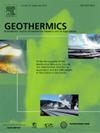Geofluid circulation enhanced downhole heat exchanger for highly efficient heat extraction: Mechanism and optimization
IF 3.9
2区 工程技术
Q3 ENERGY & FUELS
引用次数: 0
Abstract
The Downhole Heat Exchanger (DHE) is critical for the development of geothermal energy. However, conventional DHEs experience a gradual reduction in heat extraction efficiency over time. The study developed a geothermal heat extraction scheme based on forced convection of geothermal fluid (geofluid), with the heat transfer process simulated using an experimental setup. Experimental results showed that enhanced DHE achieves higher temperature rises than the conventional version. This confirms the feasibility of enhancing heat transfer efficiency through forced geofluid circulation. Building on this, the study further investigated the mechanism of the enhanced DHE through numerical simulations, aiming to reveal its heat transfer characteristics and optimize parameters including geofluid flow direction, circulation rate, production casing length, and outer casing length. The results show that the enhanced DHE outperforms the conventional version in production temperature, heat extraction power, and net power. Continuous production creates a low-temperature region near the reinjection point, affecting long-term performance. Geofluid circulation acts as the key mechanism for heat extraction, intricately linking the evolution of heat extraction with geofluid flow in the aquifer. It is recommended to circulate geofluid upstream at a rate of 400 m³/d. Extending the lengths of the middle casing and outer casing enhances heat extraction power. By balancing heat transfer efficiency and economic cost, the optimal casing lengths are 200 m for the middle casing and 300 m for the outer casing. These findings provide valuable insights into optimizing key parameters for enhanced DHEs.
地流体循环强化井下热交换器的高效排热:机理与优化
井下换热器(DHE)是开发地热能的关键设备。然而,随着时间的推移,传统的dhe的排热效率逐渐降低。研究提出了一种基于地热流体强制对流的地热提取方案,并利用实验装置模拟了地热流体的传热过程。实验结果表明,增强型DHE的温升高于常规版本。这证实了通过强制地流体循环提高换热效率的可行性。在此基础上,通过数值模拟进一步研究了DHE增强的机理,揭示了其换热特性,并对地流体流动方向、循环速率、生产套管长度、套管外套管长度等参数进行了优化。结果表明,增强型DHE在生产温度、抽热功率和净功率方面均优于常规DHE。连续生产在回注点附近形成了一个低温区域,影响了长期性能。地流体循环是采热的关键机制,将采热演化与含水层地流体流动复杂地联系在一起。建议以400 m³/d的速率在上游循环地流体。延长中、外套管的长度,提高了抽热能力。综合考虑换热效率和经济成本,中套管长度为200 m,外套管长度为300 m。这些发现为优化增强型hes的关键参数提供了有价值的见解。
本文章由计算机程序翻译,如有差异,请以英文原文为准。
求助全文
约1分钟内获得全文
求助全文
来源期刊

Geothermics
工程技术-地球科学综合
CiteScore
7.70
自引率
15.40%
发文量
237
审稿时长
4.5 months
期刊介绍:
Geothermics is an international journal devoted to the research and development of geothermal energy. The International Board of Editors of Geothermics, which comprises specialists in the various aspects of geothermal resources, exploration and development, guarantees the balanced, comprehensive view of scientific and technological developments in this promising energy field.
It promulgates the state of the art and science of geothermal energy, its exploration and exploitation through a regular exchange of information from all parts of the world. The journal publishes articles dealing with the theory, exploration techniques and all aspects of the utilization of geothermal resources. Geothermics serves as the scientific house, or exchange medium, through which the growing community of geothermal specialists can provide and receive information.
 求助内容:
求助内容: 应助结果提醒方式:
应助结果提醒方式:


